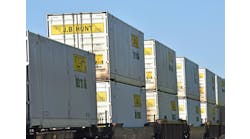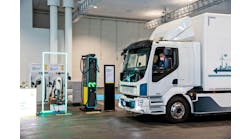And yet, the town best known for an annual two minute horse race is both a high-tech center and a logistics hub, one of those under-the-radar cities that the country — indeed, the world — relies on, even if the world doesn't know it.
As part of a recent media tour hosted by UPS, I had the chance to see the side of Louisville most people are unaware of — the supply chain side. UPS Supply Chain Solutions, a third-party logistics provider (3PL), maintains a campus occupying 2 million square feet devoted to more than 70 companies. Although the sign on the door may say UPS, inside these facilities you'll find high-tech diagnostics and repair, critical parts deployment, returns management, cross-dock facilities, product configuration and testing, and quality assurance.
For instance, Nikon Inc., a worldwide leader in cameras and digital imaging technology, manufactures its products in Korea, Japan and Indonesia — but that's just the beginning of Nikon's supply chain. From the Far East, Nikon's freight is directed to Louisville, where it is either kitted with accessories such as batteries and chargers, or repackaged according to retail store display specifications. And then, since UPS' Worldport global air operations are located at the Louisville airport, the packages can be shipped to anywhere in the world.
It's no accident that Nikon would center its product distribution in Louisville, on the same campus where Toshiba America bases its laptop repair facility, and numerous other high-tech, healthcare, consumer goods and automotive companies focus a crucial component of their supply chain activities. From Worldport, UPS handles over 1 million packages per day, averaging 135 daily in-bound flights.
While the physical operations are quite impressive, occupying 4 million square feet and more than 100 miles of conveyors in the package system, it's the technology that makes all the heavy lifting possible. Worldport processes 59 million database transactions per hour. And, again, all of this is taking place in Louisville.
The story is the same in other offthe-beaten track cities, where access to highways and airports have created first-class logistics hubs. Take a close look at Logistics Today's list of the Top 50 Most Logistics-Friendly Cities in America (available on our website at www. logisticstoday.com). You'll see Louisville there, of course, along with medium-sized cities like Indianapolis, Memphis and Columbus, Ohio — places where rival express delivery companies FedEx and DHL maintain their airport hubs.
The mainstream press, which tends to get preoccupied with doom-and-gloom stories, has pretty much missed it, but there's a distinct shift to the logistics side in the U.S. Outsourcing is not synonymous with taking jobs away from America.
"Look at Sparks, Nevada, which was basically a wide spot in the road 20 years ago," observes Brooks Bentz, an associate partner with Accenture. "Sparks today is one of the major areas for third-party warehouses."
"If you're trying to run a lean manufacturing or a build-to-order operation, the appeal of having a clustering of related activities around a particular manufacturer is terrific because you're not worried about infrastructure, or not being able to handle movement," adds Robert Lieb, professor of supply chain management at Northeastern University.
The extreme version of this trend, Bentz notes, is underway in China, where at least two cities are being built virtually from the ground up as supply chain hubs. "A manufacturer and all of its suppliers will be in the same community," Bentz explains. "These are cities of several hundred thousand people that will basically be a self-contained supply chain."
According to Lieb, there are some 50 proposals throughout the U.S. to create "villages" centered around certain industries, with access to major transportation infrastructure. The only thing standing in the way — and it's a big thing — is figuring out where the money to develop these villages is going to come from.
Make no mistake, though, these supply chain villages are part of the wave of the future, illustrating that with logistics, as with baseball parks, if you build it, they will come.



